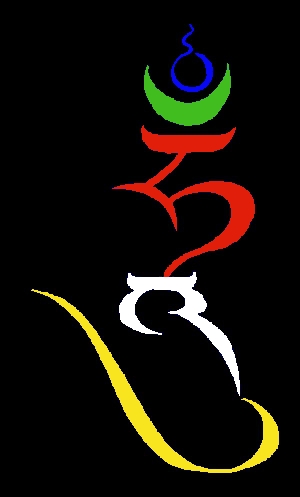
Hung
the seed syllable of Padmasambhava and Yeshé Tsogyel
In this image of the seed syllable Hung we see the syllable portrayed in the colours of the elements. The thig-lé is the symbol of space and is blue, the colour of the space element. Below this the half-moon is green, the colour of the air element. Below the half moon the letter Ha is red, the colour of the fire element. The ’a is white, the colour of the water element. At the nadir of the syllable the vowel mark is yellow, the colour of the earth element. Thus Hung represents the kyil’khor of the Buddha families, the dance of the dakas and dakinis, the kyil’khor of the five elements. It manifests the transformation of the skandhas and the neuroses.
Hung can also be understood in terms of the six realms. From this perspective we would append to the calligraphy the gTérma mark (two little circles divided by a crescent moon), as the sixth aspect of the form of the syllable Hung. These six segments equate with the six realms and the liberation of all beings within the six realms. In this way, this group of six segments equates with the recitation of the mantra of Chenrézigs, the mantra of six syllables which liberates beings in all the six realms. Hence Hung is the catalyst for the liberation of beings within the five neurotic patterns of duality and the six realms of dualistic fixation.
The colours of the Hung according to the liberation of beings from the six realms is different from that of the five elements – the entire sequence changes. From the top down: the thig-lé is off-white (gods); the crescent moon is olive green (asuras or jealous gods); the Ha is dusky red (humans); the ’a is palid yellow (animals); the vowel mark is brown (yidag or hungry ghosts); and the gTérma marks are black (hell beings).
